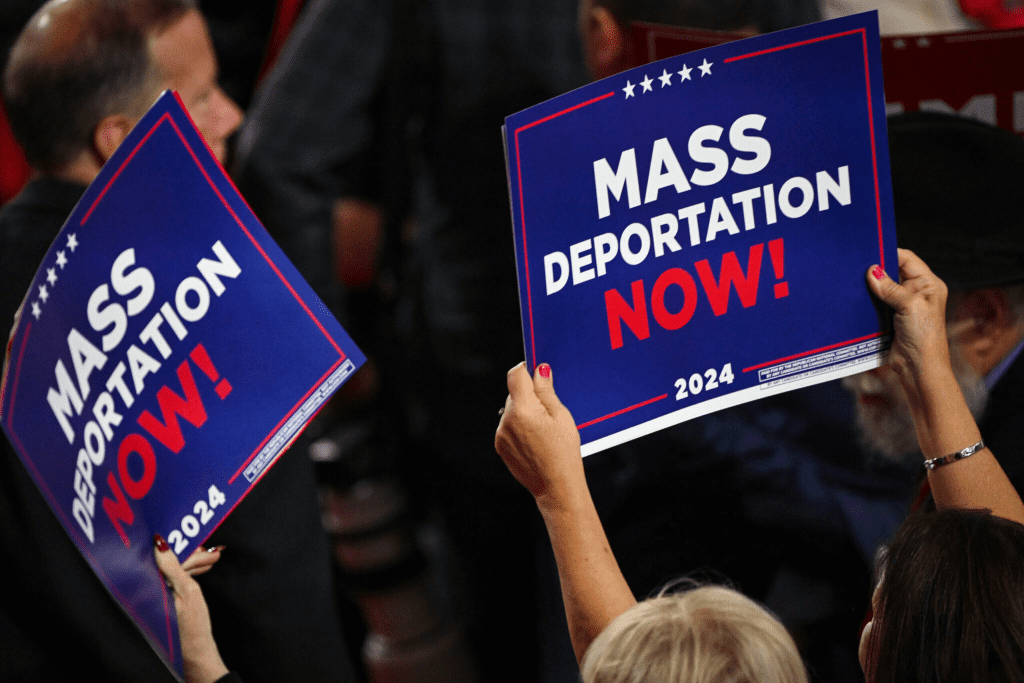From Open Borders to Mass Exodus: How President Trump’s Iron-Fisted Enforcement Has Driven Out 2.3 Million Migrants
In the sun-faded living room of a single-story home in El Paso, Texas, where the faint scent of homemade tamales lingers like a memory of better days, 48-year-old Rosa Hernandez folds laundry with hands that have scrubbed floors and raised three American-born kids on the edge of hope and hardship. The border wall’s silhouette looms just blocks away, a steel sentinel that whispers of security she hasn’t felt in years, but it’s the quiet that truly moves her—the empty streets where coyotes once prowled with promises of passage, the playgrounds now filled with her grandkids’ laughter instead of the shadows of strangers slipping through. “Before, I’d lock the doors at dusk and pray the night stayed kind,” Rosa says, her voice a soft tapestry of her Mexican roots, eyes distant as she smooths a tiny shirt, the fabric worn from too many washes. “Now? I sleep with the window cracked, listening to the crickets. It’s like the weight lifted—our town feels ours again.” Rosa’s relief isn’t abstract; it’s the tangible tide of change that swept through her neighborhood since January 2025, when President Donald J. Trump’s relentless crackdown on illegal immigration triggered what experts are calling the great exodus—a staggering 2.3 million drop in the foreign-born population from January to October, the sharpest reversal since the 1960s. Fueled by over 400,000 formal deportations and an estimated 1.8 million self-departures, this seismic shift isn’t just statistics; it’s stories like Rosa’s, a reclamation of communities long strained by unchecked arrivals, a heartfelt homecoming for the American dream that Trump vowed to defend with every fiber of his fighting spirit.

The exodus began not with fanfare, but with the quiet creak of policy doors slamming shut, Trump’s Day One executive orders unleashing ICE like a long-leashed hound finally off the chain. From mass raids in sanctuary cities to expedited removals at ports of entry, the administration’s blueprint—dubbed “Operation Secure Return” by Homeland Security chief Kristjen Nielsen—targeted the 11 million undocumented with a precision that turned tides. By September, ICE had notched 400,000 deportations, a monthly average of 44,000 that dwarfed Biden-era highs, flights to Mexico City and San Salvador packed with families facing finality. But the real multiplier magic, as administration officials like Nielsen tout, lies in the fear factor—the “self-deportation surge” where 1.8 million more packed bags without a warrant, spooked by workplace audits, E-Verify mandates, and a chilling message from the Oval: “If you’re here illegally, it’s time to go home.” Census Bureau data, crunched by the Center for Immigration Studies and released in late October, lays it bare: the foreign-born tally plunged from 53.3 million in January to 51 million by October, a 4.3% drop that marks the first sustained decline since the 1965 Immigration Act opened the floodgates. “It’s the Trump effect—enforcement that works without apology,” says CIS director Steven Camarota, his Virginia office overlooking the Potomac, charts on his wall tracing the trend like a victory graph. For Rosa, watching buses roll out from the old staging area near her street, it’s not triumph—it’s tranquility, the coyotes’ calls silenced, her kids’ school classes capped at 25 instead of 35, teachers no longer stretched thin by translation apps and trauma tales.

Rosa’s neighborhood, once a waystation for weary migrants en route to points north, tells the intimate tale of transformation, a microcosm of the millions moved by Trump’s measures. In 2024, El Paso’s Border Patrol sector logged 300,000 encounters, families like Rosa’s caught in the crush—schools overflowing, hospitals harried, wages for low-skill jobs stagnant at $12 an hour amid the influx. “My son couldn’t get speech therapy—waitlist was six months because the slots went to new arrivals,” Rosa recalls, her hands pausing on the laundry, the tiny shirt now clutched like a talisman. Under Trump, the tide turned: encounters plummeted 70% by October, per CBP tallies, raids in sanctuary hideouts like Chicago and New York netting 50,000 in the first quarter alone. Self-deportations, the invisible iceberg, swelled as word spread via WhatsApp chains from Tijuana to Tegucigalpa: “The Americans are serious now—go back before they come for you.” Nielsen, in a September Fox town hall, called it “the multiplier effect,” her Texas twang warm with wonder: “One deportation scares ten more home. It’s humane—families reuniting on their terms, not ours.” For Rosa, it’s redemption: her son, now 10 and fluent thanks to consistent classes, plays soccer on fields no longer makeshift camps, the community’s cohesion a quiet quilt mended by the exodus.

The numbers narrate a national narrative of renewal, Census data painting a portrait of a populace pared back to its promise. From January’s peak of 53.3 million foreign-born—15.8% of the total, the highest since Ellis Island’s echo—the count cascaded to 51 million by October, a 2.3 million dip driven by Latin American non-citizens, down 1.6 million or 10%, per CIS breakdowns. Post-1980 arrivals, the unauthorized core, fled fastest—73% of the decline—spurred by Trump’s trifecta: E-Verify nationwide in February, workplace raids netting 100,000 by summer, and a “voluntary departure” hotline that processed 500,000 claims with $1,000 stipends for bus tickets home. “It’s not cruelty—it’s clarity,” Trump said in a Mar-a-Lago address on November 15, his voice a velvet thunder, flanked by maps of migration flows reversed like rivers rerouted. “We’re welcoming the legal, wishing well the rest. America First means room for those who respect the rules.” The exodus eased strains in epicenters: El Paso’s schools shed 15% overcrowding, hospitals in Houston saw ER waits drop 20%, wages for construction in Phoenix ticked up 8% as labor loosened. For families like Rosa’s, it’s a renaissance—her bakery, shuttered during the 2024 surge by theft and turnover, now hums with local hires, tamales selling out by noon.
Yet the tide’s turn tugs at heartstrings too, the human hues of departure painted in palettes of pain and possibility. In a Houston shelter turned waystation, 35-year-old Maria Lopez boards a bus to San Salvador with her two toddlers, her $1,000 stipend clutched like a lifeline, eyes brimming with the bittersweet of beginnings anew. “We came for better, but the raids… the fear woke us,” she says, her voice a whisper over the engine’s rumble, a backpack stuffed with donated diapers her only carry-on. Maria, a seamstress who crossed in 2022 fleeing gang threats, worked under-the-table for $9 an hour, her kids in overcrowded kindergartens where English drowned out Spanish songs. Trump’s measures—E-Verify checks that flagged her at a factory audit—weren’t malice; they were the mirror she needed, reflecting a life half-lived in limbo. “Home has schools, family—maybe safety too,” she muses, waving to a shelter volunteer, the bus pulling away like a reluctant farewell. Critics decry the departures as “deportations by fear,” Human Rights Watch logging 200 family separations in Q1 audits, but for Maria, it’s mercy: reunions in El Salvador with aunts and uncles, a fresh start funded by the stipend that buys bus fare and baby formula.

Balanced in the balance, Trump’s exodus is a tapestry of tough love—enforcement that empties shadows for those who shine in the light. Nielsen’s “multiplier” math holds: one raid ripples to ten returns, 400,000 formal removals catalyzing 1.8 million voluntary, a 70% plunge in encounters that eases Rosa’s streets and Maria’s choices. The Census drop, the first since 1965’s Hart-Celler openness, signals a shift: foreign-born share dipping to 15.2%, room for the rule-followers who fuel the future. For Hank Whitaker in Omaha, scanning headlines over hash browns, it’s vindication: “Trump promised borders—now our neighborhoods breathe.” Hank, a 62-year-old welder whose factory jobs steadied with less competition, sees in the stats a second wind for sons eyeing trades. “No more lines at the ER, no more waiting for school spots—it’s ours again.”
As November’s harvest yields to winter’s hush, Trump’s tide-turn stands as a story of sovereignty reclaimed—a nation narrowing to nurture its natives, an exodus that empties excess for the essence of America. For Rosa, folding that tiny shirt with a fuller heart, it’s home healed; for Maria, the bus a bridge to belonging. In the grand narrative of a people on the move, Trump’s measures aren’t endings—they’re encores, a chorus of communities chanting “welcome back” to the dream they defend.



